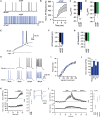Neuromodulation via the Cerebrospinal Fluid: Insights from Recent in Vitro Studies
- PMID: 29459822
- PMCID: PMC5807333
- DOI: 10.3389/fncir.2018.00005
Neuromodulation via the Cerebrospinal Fluid: Insights from Recent in Vitro Studies
Abstract
The cerebrospinal fluid (CSF) occupies the brain's ventricles and subarachnoid space and, together with the interstitial fluid (ISF), forms a continuous fluidic network that bathes all cells of the central nervous system (CNS). As such, the CSF is well positioned to actively distribute neuromodulators to neural circuits in vivo via volume transmission. Recent in vitro experimental work in brain slices and neuronal cultures has shown that human CSF indeed contains neuromodulators that strongly influence neuronal activity. Here we briefly summarize these new findings and discuss their potential relevance to neural circuits in health and disease.
Keywords: cerebrospinal fluid; neural circuit; neuromodulation.
Figures




Similar articles
-
The system of cerebrospinal fluid-contacting neurons. Its supposed role in the nonsynaptic signal transmission of the brain.Histol Histopathol. 2004 Apr;19(2):607-28. doi: 10.14670/HH-19.607. Histol Histopathol. 2004. PMID: 15024719 Review.
-
Using the cerebrospinal fluid to understand ingestive behavior.Physiol Behav. 2017 Sep 1;178:172-178. doi: 10.1016/j.physbeh.2016.11.037. Epub 2016 Dec 5. Physiol Behav. 2017. PMID: 27923718 Free PMC article. Review.
-
The role of brain barriers in fluid movement in the CNS: is there a 'glymphatic' system?Acta Neuropathol. 2018 Mar;135(3):387-407. doi: 10.1007/s00401-018-1812-4. Epub 2018 Feb 10. Acta Neuropathol. 2018. PMID: 29428972 Review.
-
Transcranial direct current stimulation alters cerebrospinal fluid-interstitial fluid exchange in mouse brain.Brain Stimul. 2024 May-Jun;17(3):620-632. doi: 10.1016/j.brs.2024.04.009. Epub 2024 Apr 28. Brain Stimul. 2024. PMID: 38688399
-
Impact of P-Glycoprotein-Mediated Active Efflux on Drug Distribution into Lumbar Cerebrospinal Fluid in Nonhuman Primates.Drug Metab Dispos. 2020 Nov;48(11):1183-1190. doi: 10.1124/dmd.120.000099. Epub 2020 Aug 29. Drug Metab Dispos. 2020. PMID: 32862147
Cited by
-
Choroid plexus volumes and auditory verbal learning scores are associated with conversion from mild cognitive impairment to Alzheimer's disease.Brain Behav. 2024 Jul;14(7):e3611. doi: 10.1002/brb3.3611. Brain Behav. 2024. PMID: 38956818 Free PMC article.
-
Routine culture and study of adult human brain cells from neurosurgical specimens.Nat Protoc. 2022 Feb;17(2):190-221. doi: 10.1038/s41596-021-00637-8. Epub 2022 Jan 12. Nat Protoc. 2022. PMID: 35022619 Review.
-
Cell-to-Cell Communication in Learning and Memory: From Neuro- and Glio-Transmission to Information Exchange Mediated by Extracellular Vesicles.Int J Mol Sci. 2019 Dec 30;21(1):266. doi: 10.3390/ijms21010266. Int J Mol Sci. 2019. PMID: 31906013 Free PMC article. Review.
-
Potential of ex vivo organotypic slice cultures in neuro-oncology.Neuro Oncol. 2025 Feb 10;27(2):338-351. doi: 10.1093/neuonc/noae195. Neuro Oncol. 2025. PMID: 39504579 Review.
-
Calcium and Spike Timing-Dependent Plasticity.Front Cell Neurosci. 2021 Sep 20;15:727336. doi: 10.3389/fncel.2021.727336. eCollection 2021. Front Cell Neurosci. 2021. PMID: 34616278 Free PMC article. Review.
References
-
- Agnati L. F., Fuxe K., Zoli M., Ozini I., Toffano G., Ferraguti F. (1986). A correlation analysis of the regional distribution of central enkephalin and beta-endorphin immunoreactive terminals and of opiate receptors in adult and old male rats. Evidence for the existence of two main types of communication in the central nervous system: the volume transmission and the wiring transmission. Acta Physiol. Scand. 128 201–207. 10.1111/j.1748-1716.1986.tb07967.x - DOI - PubMed
Publication types
MeSH terms
Grants and funding
LinkOut - more resources
Full Text Sources
Other Literature Sources
Research Materials

